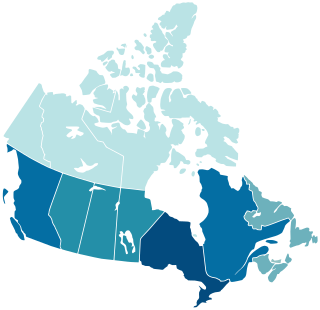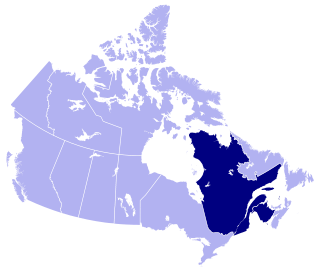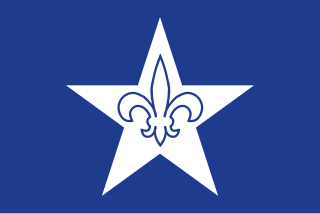The Quebec diaspora consists of Quebec immigrants and their descendants dispersed over the North American continent and historically concentrated in the New England region of the United States, Ontario, and the Canadian Prairies. The mass emigration out of Quebec occurred in the period between 1840 and the Great Depression of the 1930s. [1]
Approximately 900,000 Quebec residents [1] [2] (French Canadian for the great majority) left for the United States between 1840 and 1930. They were pushed to emigrate by overpopulation in rural areas that could not sustain them under the seigneurial system of land tenure, but also because the expansion of this system was in effect blocked by the "Château Clique" that ruled Quebec under the British administration, who reserved new land developments for the English and the English system of colonization (see Eastern Townships). New England was the preferred destination due to its growing industrialization. About half of the emigrants are reported to have eventually returned to Canada. [3] Often those who stayed organized themselves in communities sometimes known as Little Canadas. A great proportion of Americans of French ancestry trace it through Quebec. Others, particularly in the South, were from Acadia—the Cajuns—and from France directly. Until 1849, the Catholic Church was not allowed to purchase any land or establish any parishes in the Eastern Townships due to English Protestant laws and control. [4] At the initiative of Father Bernard O'Reilley, an Association des Townships was set up in 1848 to promote settlement in the area. In the 1850s, the association purchased lands which it gave to young families of farmers to prevent them from leaving for the United States where it was believed they would ultimately be assimilated.
Certain early American centres of textile manufacturing and other industries attracted significant French-Canadian populations, like Lewiston and other bordering counties in Maine; Fall River, Holyoke, Fitchburg, and Lowell in Massachusetts; Woonsocket in Rhode Island; Manchester in New Hampshire and the bordering counties in Vermont. There was a significant number of French Canadians who moved to the Kankakee, Illinois area from the 1830s through the 1870s, including religious missionaries, establishing communities such as Bourbonnais, St. Anne, St. Georges, Papineau, and L'Erable. [5] There are also sizeable populations of French-Canadian descent in Michigan and Minnesota—who began migrating there when the region was still part of New France.[ citation needed ]
The Museum of Work and Culture in Woonsocket, Rhode Island, details New England's Quebec diaspora which developed in the 19th and early 20th centuries.
Noteworthy among those whose parents settled in the United States are writer Jack Kerouac, baseball player Nap Lajoie, politician Mike Gravel, singers Rudy Vallée and Robert Goulet, Emil Beaulieau, historian Will Durant, and many more.
The largest proportion of French-Canadians outside Quebec trace their ancestry to Quebec (except in the Canadian Maritimes, which were settled by the Acadians). Ontario had been part of New France and settlements in the Detroit-Windsor area find their origins in that period.
The development of mining and forestry resources in the northeastern and eastern regions of Ontario at the end of the 19th century and early 20th century attracted a large workforce from Quebec. A great part of today's half a million Franco-Ontarians are the descendants of these Quebec emigrants. The Francophone population of Ontario is today still concentrated mainly in the northeastern and eastern parts of Ontario, close to the border with Quebec, although smaller pockets of Francophone settlement exist throughout the province in areas like Windsor, Welland and Penetanguishene.[ citation needed ]
While a good number of emigrants were from Quebec or Ontario, it is often Franco-Americans who formed the nucleus of the population in several francophone communities of Western Canada. These populations today self-identify with their province of residence (Franco-Manitobans, Fransaskois, Franco-Albertans or Franco-Columbians).

The Acadians are an ethnic group descended from the French who settled in the New France colony of Acadia during the 17th and 18th centuries. Most Acadians live in the Northern American region of Acadia, as it is the region where the descendants of a few Acadians who escaped the Expulsion of the Acadians re-settled. Most Acadians in Canada continue to live in majority French-speaking communities, notably those in New Brunswick where Acadians and Francophones are granted autonomy in areas such as education and health.

Canada is divided into 10 provinces and three territories. The majority of Canada's population is concentrated in the areas close to the Canada–US border. Its four largest provinces by area are also its most populous; together they account for 86.5% of the country's population. The territories account for over a third of Canada's area but are home to only 0.32% of its population, which skews the national population density value.

French Canadians, or Franco-Canadians, are an ethnic group who trace their ancestry to French colonists who settled in France's colony of Canada beginning in the 17th century.

Canada East was the northeastern portion of the United Province of Canada. Lord Durham's Report investigating the causes of the Upper and Lower Canada Rebellions recommended merging those two colonies. The new colony, known as the Province of Canada, was created by the Act of Union 1840 passed by the Parliament of the United Kingdom, having effect in 1841. For administrative purposes, the new Province was subdivided into Canada West and Canada East. The former name of "Lower Canada" came back into official use in 1849, and as of the Canadian Confederation of 1867 it formed the newly created province of Quebec.
The French language is spoken as a minority language in the United States. Roughly 2.1 million Americans over the age of five reported speaking the language at home in a federal 2010 estimate, making French the fourth most-spoken language in the nation behind English, Spanish, and Chinese.

Franco-Ontarians are Francophone Canadians that reside in the province of Ontario. Most are French Canadians from Ontario. In 2016, the Government of Ontario calculated that there are approximately 622,415 francophones residing in the province. The majority of Franco-Ontarians in the province reside in Eastern Ontario, Northeastern Ontario, and Central Ontario, although small francophone communities may be found in other regions of the province.
In Canada, an allophone is a resident whose first language is neither French nor English. The term parallels anglophone and francophone, which designate people whose mother tongues are English and French, respectively. Some sources do not consider native speakers of Indigenous languages to be allophones.
Little Canada is a name for any of the various communities where French Canadians congregated upon emigrating to the United States, in particular New England, in the 19th and early 20th centuries. A variant of Canadian French known as New England French is still spoken in parts of New England.

French America, sometimes called Franco-America, in contrast to Anglo-America, is the French-speaking community of people and their diaspora, notably those tracing back origins to New France, the early French colonization of the Americas. The Canadian province of Quebec is the centre of the community and is the point of origin of most of French America. It also includes communities in all provinces of Canada, Saint Pierre and Miquelon, Saint Martin, Saint Barthélemy, Martinique, Guadeloupe, Saint Lucia and Haiti in the Caribbean; French Guiana in South America. Also there are minorities of French speakers in part of the United States, the Dominican Republic, Dominica, Grenada and Trinidad and Tobago.
Le Droit is a Canadian French-language daily newspaper, published in Gatineau, Quebec. Initially established and owned by the Missionary Oblates of Mary Immaculate, the paper was published by Martin Cauchon and his company, Capitales Médias, from 2015 - ? when a cooperative was formed by the employees to continue publishing the paper.

French is the mother tongue of approximately 7.2 million Canadians according to the 2016 Canadian Census. Most Canadian native speakers of French live in Quebec, the only province where French is the majority language and the only province in which it is the sole official language. Of Quebec's people, 71.2 percent are native francophones and 95 percent speak French as their first or second language.

French Americans or Franco-Americans are citizens or nationals of the United States who identify themselves with having full or partial French or French-Canadian heritage, ethnicity and/or ancestral ties. They include French-Canadian Americans, whose experience and identity differ from the broader community.
Canadian Americans are American citizens or in some uses residents whose ancestry is wholly or partly Canadian, or citizens of either country that hold dual citizenship.
Canadian French is the French language as it is spoken in Canada. It includes multiple varieties, the most prominent of which is Québécois. Formerly Canadian French referred solely to Quebec French and the closely related varieties of Ontario (Franco-Ontarian) and Western Canada—in contrast with Acadian French, which is spoken by Acadians in New Brunswick and some areas of Nova Scotia, Prince Edward Island and Newfoundland & Labrador.

New England French is a variety of French spoken in the New England region of the United States. It descends from Canadian French because it originally came from French Canadians who immigrated to New England during the Grande Hémorragie.

French-Canadian Americans are Americans of French-Canadian descent. About 2.1 million U.S. residents cited this ancestry in the 2010 U.S. Census; the majority of them speak French at home. Americans of French-Canadian descent are most heavily concentrated in New England, New York State, Louisiana and the Midwest. Their ancestors mostly arrived in the United States from Quebec between 1840 and 1930, though some families became established as early as the 17th and 18th centuries.
The Kashubian diaspora resulted from the emigration of Kashubians mainly in two waves occurring in the second half of the 19th century. The majority of Kashubian emigrants settled in the United States; others emigrated to Canada and Brazil. An online genealogical project, "The Great Kashubian Migration," is devoted to tracking their settlement patterns. Their reasons for emigration varied. Until the Franco-Prussian War, Kashubians emigrated primarily for economic reasons. After the Franco-Prussian War and especially due to the Kulturkampf, Kashubian emigration accelerated as socio-political factors came into play. In his 1899 book, Statystyka ludnosci kaszubskiej, the Kashubophile linguist and sociologist Stefan Ramult estimated that 130,700 Kashubians were living in the Americas.

The Franco-Americans, or French Americans, are a group of people of French and French-Canadian descent living in the United States. Today there are 11.8 million Franco-Americans in the US and 1.6 million Franco-Americans who speak French at home. There are also an additional 450,000 Americans who speak a French-based creole language, for example, Haitian Creole. Even though Franco-Americans are a substantial portion of the US population, they are generally less visible than other sizable ethnic groups. This is partly because of geographical dispersal, and partly because a large proportion of Franco-Americans have acculturated or assimilated.

Interprovincial migration in Canada is the movement by people from one Canadian province or territory to another with the intention of settling, permanently or temporarily, in the new province or territory; it is more-or-less stable over time. In fiscal year 2019–20, 278,316 Canadians migrated province, representing 0.729% of the population.
Francophone Canadians are citizens of Canada who speak French. In 2011, 9,809,155 people in Canada, or 30.1% of the population, were Francophone, including 7,274,090 people, or 22% of the population, who declared that they had French as their mother tongue.